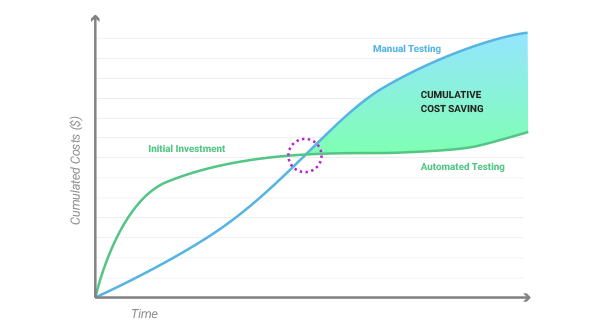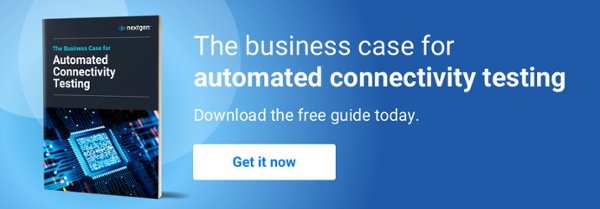How to Measure and Communicate the ROI of Automated Testing
Being able to calculate the ROI on an automated testing investment is crucial.
Yes, automated testing is the only practical way to check every feature, every potential use case, and ensure your customer enjoys a gold level of performance from each of your products. And yes, it brings a raft of benefits to every manufacturer keen to maintain and strengthen its reputation, market share and financial performance.
These include:
- Guaranteed consistency, wherever your test teams are located, because every test is identical and completed using the precise same methodology.
- Testing like an end user, because the depth of testing available through automation is significantly greater than that offered by a manual testing regime.
- Bug accountability, with faults accurately traced back through complex and diverse supply chains. When ownership of any fault is indisputable, fixes are reached quicker.
- Reduced costs per test, which are universally realised in testing scenarios once any initial investment in automation is overcome.
- Increased customer loyalty and reduced customer churn, because products go to market with far more problems identified and resolved during the testing process.
- Faster testing, because automated tests can operate 24/7 and once in place do not require as much staff supervision.
- Global connectivity testing, allowing you to test regional variants at the necessary speed and scale to ensure successful product launches.
- Increased test cycle times, helping you to avoid being outpaced by competitors and reinforcing your market position.
However, making the case for automated testing still requires rigour and financial insight.
Whether you’re trying to convince your organisation to make its first investment in automated testing, or expand its current capabilities, being able to determine and evidence the precise ROI of automated testing is always likely to be the most successful way to secure support from C-suite decision makers.

How to Calculate the ROI of Your Automated Testing Investment
Calculating the return on investment of automated testing is relatively straightforward. It requires two sets of data. First, you must identify all the necessary expenditure for your organisation to put automation in place. You must also establish all the benefits of automated testing.
Once you have this information at hand, simply divide net benefits by net investment, then multiply that figure by 100.
Common issues to consider here include:
- Number of releases per year (the more releases your organisation makes, the more it is likely to save)
- Test coverage (the higher percentage of tests you intend to automate, the greater the potential benefits)
- Average costs of manual testers (if you are in Silicon Valley, for example, the salary demands of your manual testers are likely to be among the highest in the world)
Calculating net benefits is simpler than determining an overall ROI. Simply subtract investment costs such as licenses, installations and configurations from savings in areas such as test, risk reduction and remediation costs.
What to Expect in Your Automated Testing ROI Calculations
Instigating automated testing in any QA environment generally results in a common pattern emerging.
Complex early investments make the initial costs appear high. But over time the outlays start to reduce and the test efficiency starts to improve. This means ongoing costs quickly level off. It is at this point that automated testing becomes a more attractive proposition than manual testing.

In contrast, manual testing demands investment every time a test is conducted. There is no benefit of scale: conducting 100 tests costs 100 times more than conducting a single test.
This is one of the main reasons why, over the medium and long term, the ROI of automated testing is far more compelling than the irreducible costs of manual testing.
Automated testing also provides unquantifiable returns, such as more extensive testing that leads to the subsequent avoidance of PR disasters.
What Type of ROI Calculations Are Best Suited to Automated Testing?
Three types of calculations are particularly appropriate to consider when you are producing the business case for investing in automated testing.
1. The Value of Automated Testing
Automated testing comes into its own when you run tests multiple times. This is the quickest way for your ROI to become clear compared to manual testing. With automation, you can also enjoy 24/7 and unattended testing, as well as increased test coverage thanks to automation’s capacity to conduct tests that are simply too complex for human testers.
2. The Cost of Creating New Automation Tests
Calculate an initial automation time by multiplying the number of the tests by the person-hours you need to develop and maintain each test. To arrive at your cost for creating new automated tests, simply multiplying your initial automation time by your QA’s team average hourly salary.
3. The Cost of Automating Regression Tests
To arrive at this cost, multiply your total automation time (regression tests x person-hours needed to maintain each test) by the average cost of your test engineers, then multiply that figure by the number of engineers you’ll need.
Introducing Automated Testing Into Your Process
If you’re ready to take the plunge and introduce automation into your organisation’s testing regime, some basic steps will help you to maximise your decision.
- Look for scalable automation systems which are flexible enough to cover different use cases.
- Automation is unlikely to account for 100% of your test cases, so look for systems that integrate in a lab environment that supports both manual and automated test processes.
- Maintenance and updates are still necessary. Take care to ensure your automation platform continues to deliver value over time.
- Focus on long-term ROI calculations to give you the best perspective on strategic investment decisions.
- Remember to factor in additional ‘hidden’ costs, such as ongoing training (although this can be reduced by opting for low code or graphical-UI based systems).
Secure Your Automation Investment
Don’t assume your colleagues instinctively understand that automated testing delivers a stronger ROI than manual testing.
Take time to document in detail the process of integrating or expanding automated testing. And be transparent about the costs involved.
It is only then that you will gain the trust necessary for your ROI calculations to be accepted - and the investment granted.




